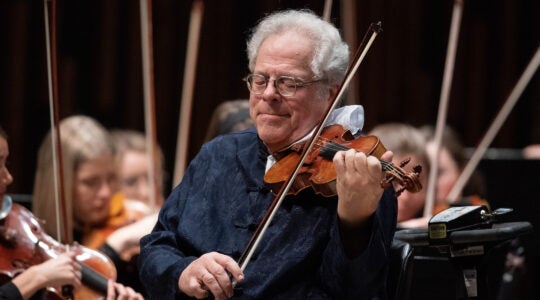Forget the sports teams, the debating club, or the science lab.
Get used to a more crowded classroom, with only one teacher. And if there are any computers, they won’t be state-of-the-art.
Welcome to the low-cost, no-frills yeshiva, an idea whose time may have come in this era of financial struggle, and one that could be a reality as soon as next year.
The Orthodox Union says 135 existing schools in North America are in discussions about creating new, discount full-time Jewish education for $6,500 per year, or less than half the current average of $15,000.
The initiative is a sign of growing concern that the recession, which compounded an already festering crisis of soaring tuition, will drive observant families en masse to public schools.
“In the past five years average tuition increases have been something along the lines of 7 percent a year,” said Rabbi Saul Zucker, director of the OU’s department of day school and educational services. “Parents paying tuition over the past five years have had [average] raises [in income] of 3.4 percent.”
And in an age of sweeping layoffs, salary cuts and declining business revenues, yeshivas are being bombarded more than ever with scholarship requests.
Rabbi Zucker said he was aware of only one yeshiva, the Joseph Kushner Academy in Livingston, N.J., that plans to reduce tuition next year, by $200. Most, he said, would increase tuition.
Anecdotal evidence, he added, already shows that Orthodox registration in public schools, once as taboo as driving on the Sabbath, is on the rise.
“The other day someone who lives in the Five Towns told me he can name six kids he knows that are in public school, strictly for financial reasons, not because of special needs,” said the rabbi. “And when I attended a conference in Los Angeles, I was told the public elementary school in Beverlywood [a district in West Los Angeles] has recently adopted a policy of no homework during Sukkot because of the number of Orthodox students.”
At the current rate of tuition inflation, he predicted, “if we do nothing, in five years the entire day school system will crush in on itself.”
There is currently only one no-frills, low-cost yeshiva in the active planning stages. It is expected to open in Englewood, N.J., for the 2010-2011 school year. About 100 families have expressed interest. Rabbi Zucker predicted there would be at least two others by that time.
“There is interest in two other communities that called in to say they are waiting to see what happens in Englewood,” said Rabbi Zucker. “I think it will serve as a model.”
But it remains to be seen whether a scaled-down yeshiva with few amenities will be substantial and attractive enough to sway parents who might be considering public schools.
In a recent column in the Jewish Standard of New Jersey, Amy Citron, 31, a physical therapist from Teaneck, called for a large-scale defection of Orthodox families to public schools in order to create a social cohort, with lower-cost religion instruction after dismissal. She argued that the lifting of the financial burden would allow families to spend more time together and give more money to charity.
In an interview, Citron, who has four children in Yavneh Academy in Paramus, predicted that the low-cost yeshiva would appeal to “typical middle-class families who are struggling and can barely stay afloat, even if they are making over $200,000 a year, and are still not able to save for retirement, college, or weddings — all the important things in life, or have an emergency fund in case, God forbid, you lose your job.”
“We need to have affordable education that allows middle-class people to still live reasonably well.”
With the money saved, Citron continued, “there are definitely people who can afford to give their children all the extracurricular activities they are missing by funding that privately.”
While some parents may be leery that a low-cost school would, by definition, mean lower educational standards, Rabbi Zucker stressed that “belt-tightening by no means means you are sacrificing quality. We are looking to pay teachers the same, maybe even more.”
But there would be fewer of them in each grade. Perhaps the biggest impact would be on the teacher-student ratio, which could take a toll on individual grades. But Rabbi Zucker added that with the cost of tuition being slashed, parents could then have resources to hire tutors. “It gives them a little more wiggle room for that,” said the rabbi.
But some parents are skeptical.
“That would work if we lived in a shtetl,” said Saul Stern, 38, of West Hempstead, L.I., who has two children at the Hebrew Academy of the Five Towns and Rockaway (HAFTR). “It doesn’t work if we hope for our kids to be able to compete. Our kids would get out of the shtetl schools and have to compete with kids who have had all the resources.”
Calling the idea a “Band Aid,” Stern added, “This is all a ruse to avoid the inevitable fact that you can’t pay for both private and public school [through tuition and taxes] unless you’re wealthy. It’s the communal structure that has to change.”
Juda Engelmayer, 38, of the Lower East Side, said that extracurricular activities and enrichment programs, which would presumably be absent from the low-cost schools, were essential to a successful yeshiva program.
“Gym class, art and basketball are essential and necessary [for students] to be well-rounded and kept in the right direction,” said Engelmayer, whose family pays more than $65,000 in tuition for three children at Ramaz. “You can’t just expect them to sit and stare at books all day. … It’s a nice idea to keep tuition low, but the wrong approach.”
Shea Rubenstein, director of the Jewish Community Council of Marine Park, a social service organization in the growing Jewish community in that Brooklyn neighborhood, said he has been fielding a growing number of requests for assistance from families struggling with tuition costs.
“All day long people are calling and looking for help,” he said.
While many people discuss the option of enrolling perhaps thousands of Orthodox children in public schools, either to “take over” an entire school district or to leverage some kind of tax break or voucher program, many feel the likelihood would be that such children would only be bused to underperforming schools because the ones in their district are full.
Rubenstein predicted that a low-cost school would not appeal to parents in his community. “Most people won’t go for it,” he said. “They want their kids to be in the best institutions, promoting their values, regardless of the price. That’s not going to change to save $2,000 or $3,000 per child.”
Rubenstein noted that his children attend ultra-Orthodox schools where the tuition is already around the same as the $6,500 Rabbi Zucker envisions. At chasidic schools, he noted, tuition can be as little as $2,500.
He said these schools have large class sizes and don’t pay teachers and administrators as well as Modern Orthodox yeshivas. But more than that, they benefit from more of a communal responsibility to fundraise.
“Whether it’s the alumni or the rebbe speaking at a melave malke [post-Shabbat party] or a dinner, they expect people to cough it up,” said Rubenstein.
In addition to the low-cost yeshiva initiative, Rabbi Zucker and a task force of education experts have been working on creating a funding stream via an online toolbar that would generate income per click.
The money would be collected and disbursed by OU, which would absorb administrative costs. The organization is also working on a national health insurance plan for yeshiva employees, assistance with grant-writing and a voluntary Kehilla Fund that would encourage families to donate an average of $30 per month to Jewish education, whether or not they have school-age children.
And as the economic crisis deepens, thinking outside the box is likely to increase in all corners of the yeshiva world.
In Los Angeles, Rabbi Avi Greene, a former Judaic studies principal at Shalhevet High School in that city and former teacher at Long Island’s North Shore Hebrew Academy, is working to open a “hybrid” high school that would use online classes and classroom instruction for both Judaic and secular studies.
The program would take advantage of an online charter school program available in California and 37 other states, excluding New York.
“We’re in the process of putting together a board,” said Rabbi Greene, who acknowledged some skepticism. “People are nervous about the online aspect if it. If you are unfamiliar with online education, you think it may be second class.”
Reducing the amount of classroom instruction, he said, would cut costs. But he acknowledges the risks that could come with less supervision.
“There is a certain amount of self-motivation the student has to have in the first place,” said the rabbi. “But with the [online] program being supervised, and having enforced practice time and having that kind of positive peer pressure, students will go about doing the work.
“I’m hoping that by reducing costs and hopefully offering some scholarships it will allow more students to attend a school that has a [Jewish] day school atmosphere.”
E-mail: adam@jewishweek.org
The New York Jewish Week brings you the stories behind the headlines, keeping you connected to Jewish life in New York. Help sustain the reporting you trust by donating today.




